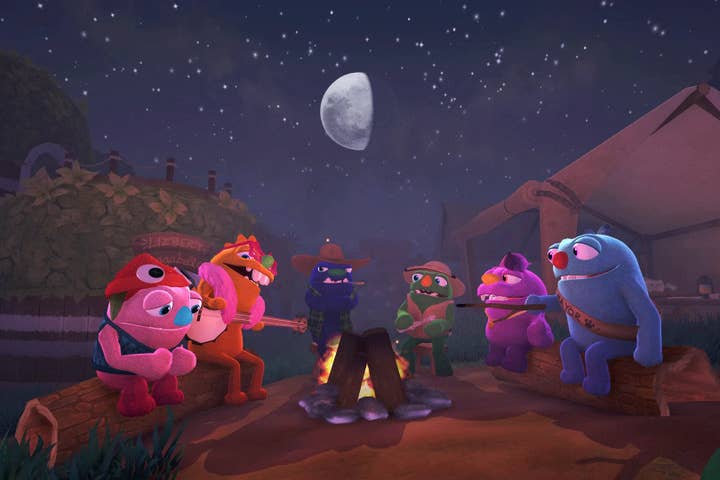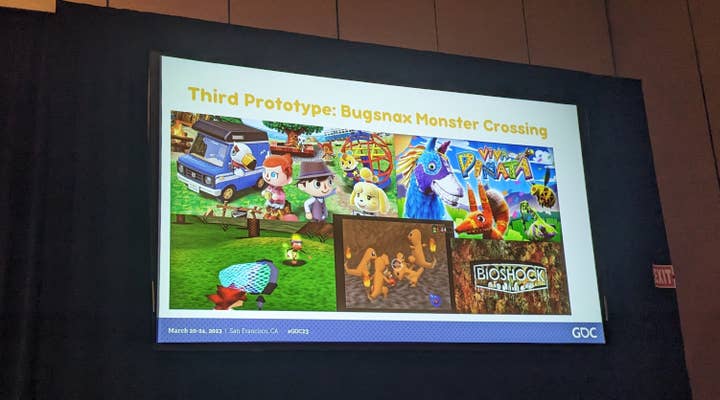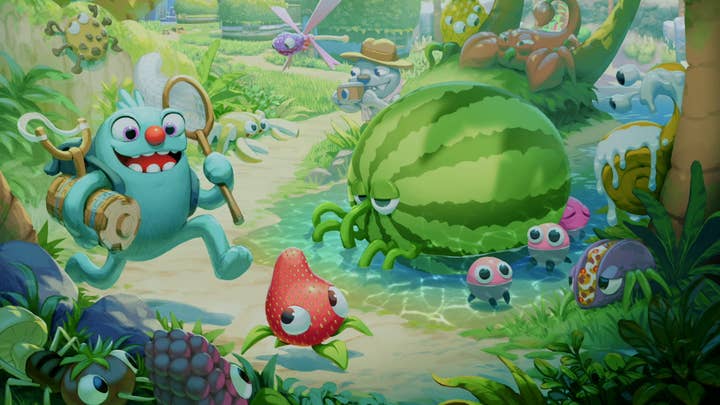Pokémon Snap, systemic comedy and siding with the player: How Bugsnax came to life
GDC 2023: Young Horses' John Murphy on Bugsnax's pitching and prototyping stages and the unexpected inspirations behind the hit
A launch title for the PlayStation 5 in 2020, Young Horses' Bugsnax very quickly become an indie darling thanks to its silly critters and fun mechanics to catch them, its compelling story, and its great cast.
At GDC yesterday, Young Horses' studio head John Murphy looked back at Bugsnax's six years of development, the challenges to follow up on the success of 2014's Octodad: Dadliest Catch, and the lessons it's taking to its next project.
While Bugsnax ultimately overtook Octodad in terms of success, Murphy shared, the process leading up to it took a lot of pitching and prototyping.
"We hadn't pitched a game in more than four years after Octodad," Murphy said. "We took a long time to figure out what we wanted to do. We were also worried about the sophomore slump. All we had known at this point was Octodad, so we ended up just returning to the same method that we learnt from mentors in school about how to decide what to make: everyone reflected on what they were preoccupied with or inspired by, and everyone on the team would pitch."
Murphy showed a few of the many inspirations that the Young Horses team had, which included things like Space Jam or "Pharrell's big hat."
"We [then] went through multiple rounds of fewer, more detailed pitches starting with elevator pitches or just titles of games – here we got things like 'Burrowing dirt bros' or 'Alternate reality Steve Irwin'. We may never know what those actually would be as games because we never got that far!"
Other ideas at this stage included game names such as "Hunger is anger" or "Game made of bones," which we're really hoping Young Horses is working on as we speak.
One of them was called "Snacksects Paradise," which remained Bugsnax's codename internally. The team then narrowed it down further by putting together one-page pitches for the remaining ideas.

"It's basically just one Trello card, an elevator pitch and a few inspirations for core mechanics. We went through like 50 of those and eventually got down to eight-page presentations that go through everything – the elevator pitch, art style, technical challenges, what the market for the game would be, games that are similar. And then we got to maybe about ten of those and then voted on the top three to prototype."
The team spent one month on each of the three prototypes. First was 'Summer Camp' – a creepy walking simulator with a misfit kid trapped in a mysterious summer camp. The team ended up abandoning the idea because "it felt like some fetch quests [with] a little bit too much walking around," Murphy explained.
The second prototype was Hellsports High, which revolved around a demon portal opening in a high school's soccer field, with the player tasked to play sports to save the school. The idea was abandoned because of the mammoth task involved to get the feel of a sports game right, especially with the programmers still involved in Octodad at this point.
And last but not least, the last prototype was Bugsnax Monster Crossing, which would eventually become the Bugsnax that we know. From the prototype stage, the team experimented with how the player was going to interact with the Grumpuses (the game's main species and NPCs) and the titular Bugsnax, as well as how 'feeding' was going to work.
"We learnt to choose our battles when it comes to what we try to innovate on... If we tried to reinvent every wheel, it would be overwhelming"
A horrific prototype involved players peeling the Bugsnax. Food trucks with cannons firing Bugsnax at the characters were also considered, and so was the idea that Bugsnax would change the characters' personalities when eating them.
"We decided that all this stuff about personalities changing didn't really work with the way that we make games, where we want really character-driven stories," Murphy explained. "It's just really hard to comprehend a character if their personality is changing."
From the prototyping stage and until a year into development, the title was heavily influenced by Pokémon Snap, Murphy also revealed, with one of the prototypes having the player be on rails, trying to catch the Bugsnax wandering around – the same way you take pictures in Pokémon Snap. But what worked in Pokémon Snap for taking pictures didn't quite work for catching snack monsters.
"It's really unforgiving to try to do anything more complicated while moving like this," Murphy said. "We tried to really slow down the movement or even stop [but] then that kind of defeated the purpose. So we decided to just abandon the on-rails thing – we were in that mode for a year. And at some point we're like, why don't we just try getting off of the rails?"
This is when the title pivoted to being more about observation and planning instead of "frenetic chasing around," with Murphy explaining that addressing these early issues helped shape the narrative as well. The free roaming aspect helped unlock the idea that the player was going to be part of the town and be interacting and feeding the Grumpuses directly.
"We decided to have the sort of first-person free-roaming perspective for all parts of the game and decided that the Grumpuses were going to be in the world and in the town or around. And then once we've made those decisions, it made the narrative much more clear: if the Grumpuses are scattered around levels, why are they there? Because their leader is missing. What do we need to do? Bring them all back home. So figuring out these mechanical issues really helped figure out the story."
From that point on, the team focused on fleshing out the mechanics, including the hunting and how the different traps were going to work (trap variants were considered but the idea was abandoned because uses overlapped, rendering some of them less useful), but also how the different sauces impacted gameplay. The focus was put on creating more agency and having the player be an active component of the interactions rather than a spectator of the Bugsnax interacting with each other.

At that point in the process, Murphy was playing Breath of the Wild and was inspired by Nintendo's title to include an elemental system in Bugsnax, with some of the spicy Bugsnax engulfed in flames, and some being icy.
Murphy said he was also inspired by Horizon Zero Dawn, and "totally stole" Guerrilla's title pathing system, which highlights the trajectory of a creature so players know where it's going to go next.
"It was interesting that these big AAA games were the main mid-dev inspirational things for us," Murphy added.
He also went into details about many other aspects of the title, including a central aspect of Bugsnax: its humour. Talking about the Bugsnax's names (all of them puns involving food and insect names), Murphy said it contributed to a "systemic comedy" that the team was trying to achieve with the game.
"With Octodad, the surprise or emergent comedy comes from the wobbliness and difficulty to control him. But when we went to these standard first-person controls, we wanted to have some of that, so we moved it into the traps and Bugsnax. But that created a little bit more tension. The more we look like a 'normal game' in terms of the mechanics, the more people want it to feel precise. So the way that we balance that is we just cheated a little bit in favour of the player."
"If the Grumpuses are scattered around levels, why are they there? Because their leader is missing. What do we need to do? Bring them all back home. Figuring out mechanical issues really helped figure out the story"
Murphy explained that some hitboxes were made bigger so things would be a bit easier on the player, as their enjoyment of the title was the priority, especially with Bugsnax wanting to retain a "mellow" feel.
"So for example, it's harder to catch flying Bugsnax. So the trap radius for flying Bugsnax is just secretly 30% bigger. We just decided that we care more about humour and surprise and really clean, elegant puzzles, so we just did what we had to do [so it wouldn't] make the players mad trying to do these things. We also wanted all these systemic elements to fit together nicely."
He added that they didn't mind things being accidentally too easy, but they did mind about things being too difficult for the player.
Concluding his talk, Murphy highlighted a few takeaways for Young Horses, and lessons the Chicago-based studio is taking into its next projects. One thing is that Murphy said that keeping the team motivated across six years of development was difficult and that they "won't be doing that again."

"When we started this, we were worried about sophomore slump, so we took a long time, thinking about our preoccupations and influences, and we pitched a lot. We went through a lot of bad ideas.You've got to go through the bad ones to get to the good ones. Next time, we plan on stepping a little bit further away from the way that we made games when we were students.
"Instead of trying to come up with this fully solidified pitch, we want to make sure that everyone is on board – we had some issues with our programmers still doing some work on Octodad when we started doing these prototypes, and they never fully caught up in terms of buy-in. So we want to focus more on just: what is everyone excited about or interested in, or really can't stop thinking about? And how do we work that into our games and just sort of try to more organically grow a game instead of trying to figure it all out so early?
"Another takeaway is that designing systems is hard! But we did pretty well for our first try. It took a lot of work to get them all to play nicely together and we've learnt to build systems more systematically in the future. To me, I think it was worth it for taking the emergent comedy of Octodad to this more systemic comedy place where, even now, I am constantly surprised, laughing at things that happen in the game that we didn't plan for."
He added that, while designing systems is hard, figuring out one of them creates this "domino effect" where every system after that is easier to figure out – though it doesn't make it easier to build, he added.
"And then also, we learnt to choose our battles when it comes to what we try to innovate on. For things like UI, we just just ripped off best practices from games that have big teams with like, you know, UX specialists. That makes it easier for us to focus on doing the weird new stuff. And it also helps to create a comfortable familiar structure.
"If we tried to reinvent every wheel, it would be overwhelming. And no one would be able to understand or want to engage with it. So having that sort of standard structure in which to do our silly things was helpful."

